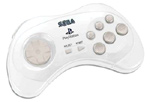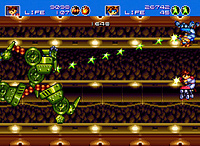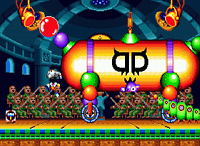Gunstar Heroes Treasure Box
 The release of Space Harrier Complete Collection marked a change in direction for Sega’s Ages 2500 series of retro rereleases for PS2. The series moved from often halfhearted 3D remakes and sometimes-clumsy ports (with some admitted gems here and there to a comprehensive effort at preserving classic Sega releases in the best state possible. Developers of the original versions of games like Space Harrier and Quartet were brought in to help ensure accuracy in each conversion. I can’t think of a better example of the turnaround Sega has accomplished with its series than this package.
The release of Space Harrier Complete Collection marked a change in direction for Sega’s Ages 2500 series of retro rereleases for PS2. The series moved from often halfhearted 3D remakes and sometimes-clumsy ports (with some admitted gems here and there to a comprehensive effort at preserving classic Sega releases in the best state possible. Developers of the original versions of games like Space Harrier and Quartet were brought in to help ensure accuracy in each conversion. I can’t think of a better example of the turnaround Sega has accomplished with its series than this package.
Overseen by Treasure president Masato Maegawa, Sega Ages Vol. 25: Gunstar Heroes Treasure Box is a compilation of the three Genesis/Megadrive games Treasure are best known for, and is just about as comprehensive in its treatment of the games as it could possibly be. Gunstar Heroes, Dynamite Headdy, and Alien Soldier are each presented in near-perfect emulation along with a host of supplementary materials.
Each game has several display options available: interlace (480i), progressive (480p), progressive with scanlines, and a non-interlaced mode. This last mode is the most sought-after of the four for those of us who still use standard-definition televisions, as it presents the games in their original resolution, pixel-perfect, without blur or interlacing, and with the scanlines right where they should be. Also included for each game are control assignment options, options to record and play back replays, a smoothing option that antialiases the onscreen image, a “deflicker” option that makes the 480i mode much easier on the eyes, and an option that can allow the emulated Genesis to display an unlimited number of sprites, removing sprite flicker from the games entirely. Gunstar Heroes and Alien Soldier both have superplays recorded by expert players included, though to be honest, Alien Soldier lends itself much better to the superplay treatment (and its replay is impressive indeed).
The Japanese and overseas (US in the case of GH and DH; PAL in the case of AS) versions of each game can be selected and played. Also hidden on the disc are the Game Gear version of Gunstar Heroes and the Game Gear and Sega Master System ports of Dynamite Headdy. In addition, there’s a hidden “prototype” version of Gunstar Heroes that has many small differences (mostly in sound effects, text, and animations) and some music used in places different from the final version. These can be accessed by holding right on the D-pad at the version-select prompt for ten seconds or so, and they remain unlocked when the system file is saved after they’re unlocked. The 8-bit ports have been given the same treatment as their Genesis siblings, and they have options that allow the player to “overclock” the emulated systems to get rid of slowdown, as well as to remove sprite display limits.
 The control options include explicit support for Sega’s Saturn control pad for PS2. Enabling the option for the pad automatically maps each game’s A, B, and C buttons to the appropriate buttons on the controller. As a side note, I can’t express how great the Saturn PS2 pad is – it feels even more smooth and responsive than the original, and the shoulder buttons are noticeably stiffer and depress with a heartier click. I find myself preferring it to either the original three-button or the six-button Genesis controller for these games.
The control options include explicit support for Sega’s Saturn control pad for PS2. Enabling the option for the pad automatically maps each game’s A, B, and C buttons to the appropriate buttons on the controller. As a side note, I can’t express how great the Saturn PS2 pad is – it feels even more smooth and responsive than the original, and the shoulder buttons are noticeably stiffer and depress with a heartier click. I find myself preferring it to either the original three-button or the six-button Genesis controller for these games.
The only problems I’ve been able to see with the emulation of the Genesis games is that a few of the FM synthesis instruments don’t sound quite right, and that the instrument mixing doesn’t seem to be done exactly as on the original hardware. While fans who still play the games regularly will probably notice it, it’s not a major issue.
The CD-ROM disc is packaged with a 53-page manual that includes full-color sections on each game in the collections, with lots of art from the original manuals. Bookending the game-specific sections are commentary by Maegawa and editors of Japanese Megadrive magazines. Included on the game disc is an “Archive” section for each game, and these sections include Japanese and overseas manuals and concept illustrations and documents for each game. Sound test modes with track titles are included for Gunstar Heroes and Alien Soldier, and a new stage select for Alien Soldier is present (which is great for practicing those boss battles).
 Dare anybody ask how these games hold up today? I’m sure a few would question them, so I reply: they’re still as beautiful and brilliant as when they were released. For the uninitiated, all three games are side-scrolling 2D action games, each with a different focus and goal.
Dare anybody ask how these games hold up today? I’m sure a few would question them, so I reply: they’re still as beautiful and brilliant as when they were released. For the uninitiated, all three games are side-scrolling 2D action games, each with a different focus and goal.
Gunstar Heroes took the run n’ gun framework that Contra established and turned it into a manic, sprawling affair with a complex weapon system, mild beat ’em up elements, and huge, multi-form bosses (including the infamous Seven Force). It set the standard for a generation of bosses, and it continues to be held up as an example of how boss battles should be done. With its use of hit points for player health instead of instant kills, it’s clearly balanced for its focus on endurance play and multiplayer sessions.
Dynamite Headdy is a platformer with mechanics more technical than most. The main character can fling his head like a boomerang in 8 directions, and can use it to attack enemies, swing himself up onto platforms, or interact with objects in his environment. The game is set as a puppet show and takes place on and behind stages, making for some unique and interesting level settings and designs. And indeed, the level design is the star of the show, with how the game constantly gives the player new ways in which to use Headdy’s head and its powered-up, modified forms.
 Alien Soldier took Gunstar Heroes’ format and weapon system and refined them into an intense, all-out boss rush with more complex controls and mechanics. Each level of the game is split up into smaller stages, and each of these stages has a short run n’ gun section followed by a boss battle. This is not to say that the non-boss sections are throwaway; rather, their purpose is to serve as obstacles that wear the player down before he or she can reach the boss. The game’s defining mechanic is the zero teleport, which lets the player become momentarily invulnerable and zoom halfway across the screen, allowing a way to quickly avoid enemy attacks. When the player’s life is at its maximum, the zero teleport transforms the player into a fiery phoenix and deals large amounts of damage to all enemies in its path. The key to Alien Soldier’s tension is maintaining full heath (or gaining it back from smaller enemies) until each boss fight, allowing the zero teleport to be used to its maximum effect. These bosses take many forms and show no mercy; the game’s high level of difficulty and layered, technical gameplay make it something that beginners at 2D action might want to save for later.
Alien Soldier took Gunstar Heroes’ format and weapon system and refined them into an intense, all-out boss rush with more complex controls and mechanics. Each level of the game is split up into smaller stages, and each of these stages has a short run n’ gun section followed by a boss battle. This is not to say that the non-boss sections are throwaway; rather, their purpose is to serve as obstacles that wear the player down before he or she can reach the boss. The game’s defining mechanic is the zero teleport, which lets the player become momentarily invulnerable and zoom halfway across the screen, allowing a way to quickly avoid enemy attacks. When the player’s life is at its maximum, the zero teleport transforms the player into a fiery phoenix and deals large amounts of damage to all enemies in its path. The key to Alien Soldier’s tension is maintaining full heath (or gaining it back from smaller enemies) until each boss fight, allowing the zero teleport to be used to its maximum effect. These bosses take many forms and show no mercy; the game’s high level of difficulty and layered, technical gameplay make it something that beginners at 2D action might want to save for later.
These games show Treasure at their most creative and coherent, and they represent the technical peak of Genesis development. Alien Soldier in particular has not been matched by 2D console development since: it was the last gasp of console 2D action before it was shoved to the margins, and as such it feels as fresh as it did in 1995 (or should have; I wasn’t able to pay Die Hard GameFan’s mail-order price for it back then).
 It’s interesting to compare the Japanese and overseas versions of the games in the package. For example, Alien Soldier’s PAL release had the classic “VISUALSHOCK! SPEEDSHOCK! SOUNDSHOCK!” slogan dropped from its title screen. Dynamite Headdy had its difficulty increased here and there for Western release, and had most enemies, stages, characters’ names changed. And in fact, the recurring enemy Trouble Bruin, known as Maruyama in the Japanese release, had all of his pre-boss-fight dialogues removed from the US release (and further differences have been catalogued in Minty Fresh Death’s FAQ).
It’s interesting to compare the Japanese and overseas versions of the games in the package. For example, Alien Soldier’s PAL release had the classic “VISUALSHOCK! SPEEDSHOCK! SOUNDSHOCK!” slogan dropped from its title screen. Dynamite Headdy had its difficulty increased here and there for Western release, and had most enemies, stages, characters’ names changed. And in fact, the recurring enemy Trouble Bruin, known as Maruyama in the Japanese release, had all of his pre-boss-fight dialogues removed from the US release (and further differences have been catalogued in Minty Fresh Death’s FAQ).
The current state of Sega’s Ages 2500 line reminds me of the treatment classic films are given via releases like the Criterion Collection. As far as I’m concerned, this is the standard to be met for retro rereleases. Some might balk at the fact that “only” three 16-bit (and three 8-bit) games are included in this package for $25, but the quality of the games contained and the care taken with their presentation makes this package more than worth the price. I would recommend this package to anybody who owns a Japanese-capable Playstation 2.
Sega Ages 2500 Vol. 25: Gunstar Heroes Treasure Box
¥2,500
2/23/2006
Sega
Playstation 2
– Gunstar Heroes Treasure Box official site (ages.sega.jp) – includes wallpaper, concept art, videos, screens, and lots of information